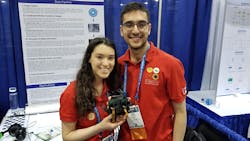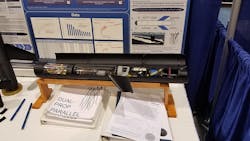I spent last week at the annual Intel International Science and Engineering Fair (ISEF) in Phoenix, Ariz. There were over 1,800 students from around the world competing for top honors. I was there with the two finalists from the Mercer Science and Engineering Fair. Sonja Michaluk earned a 4th Place award in Earth and Environmental Sciences.
I got to check out the projects at the open house on Thursday and was as impressed as ever before. The projects were varied and sophisticated, with most doing grad-school-quality projects. I will be highlighting more in the future, but here are two along with the top winners.
The team of Iam Langleben and Liana Martins-Medina presented their project entitled The Fifth Sense, A Novel Aid Device for Visually Impaired People, Translating Computer Vision into Surround Sound for Obstacle Detection (SOFT044T) (Fig. 1). They developed their own 3D vision system that generated the data to detect obstacles. This information was then turned into tones presented using a surround-sound system.
1. Iam Langleben and Liana Martins-Medina presented their project entitled “The Fifth Sense, A Novel Aid Device for Visually Impaired People, Translating Computer Vision into Surround Sound for Obstacle Detection” (SOFT044T).
I tried out the system that used a conventional set of headphones driven by the microcontroller-based system. The depth map started with a VGA resolution and was scaled to an 8 × 6 depth map. The challenge they encountered was that surround sound and the human ear does a good job of horizontal dispersion, but not as much in the vertical space. This lets someone easily hear about a tone noting an object in front or two on one side, but not how high it might be.
After a little discussion, we decided that a melodic tone from a low to high note could provide additional vertical information. It sounded, pun intended, like a good idea for future research. However, they asked me to wait while they edited their Python code. In a few minutes, they had the changes made and I was able to easily detect when an object might be down low, up high, or something like a wall via a glissando. That was rather impressive.
I also stopped by to chat with Ari Joseph Firester, who attends Hunter College High School in New York, N.Y. His project, WormBot: Mimicking Earthworm Locomotion (ROBO053), was the recipient of the IEEE Foundation Presidents' Scholarship Award of $10,000 (Fig. 2). The modular, flexible robot has retractable claws that move it forward. Ari used pneumatics to power the robot; each module had eight claws. Air pressure also provided feedback in addition to powering the system.
2. Ari Joseph Firester’s “WormBot: Mimicking Earthworm Locomotion” (ROBO053) received the IEEE Foundation Presidents' Scholarship Award of $10,000.
The top awards went to Allison Jia, Krithik Ramesh, and Rachel Seevers (Fig. 3). Krithik Ramesh, of Greenwood Village, Colorado, was awarded the Gordon E. Moore Award for developing a machine-learning technology for orthopedic surgeons. The project helps orthopedic surgeons achieve greater accuracy for screw placement during spinal surgery. The method has the potential to decrease operating time by at least 30 minutes, reducing physical-therapy recovery time by four weeks and minimizing negative side effects associated with traditional medical imaging.
3. The top awards went to Allison Jia, Krithik Ramesh and Rachel Seevers. (C. Ayers Photography/SSP)
Allison Jia of San Jose, Calif., and Rachel Seevers of Lexington, Ky., received the two Intel Foundation Young Scientist Awards. Allison Jia investigated toxic tau protein aggregates that spread in neurons in the human brain and are associated with neurodegenerative diseases such as Alzheimer’s.
Rachel Seevers designed and built a rigid, energy-efficient prototype of an underwater propulsion device that mimics the way jellyfish move through the water. Her project is entitled Bioinspired Submersible Dual Propulsion System: A Novel Approach to Ultra-Efficient Submarine Propulsion Utilizing Starting and Stopping Vortex Rings Mirroring Jellyfish Motion (ENMC025) (Fig. 4).
4. Rachel Seevers’ designed and built a rigid, energy-efficient prototype of an underwater propulsion device that mimics the way jellyfish move through the water. Her project is entitled “Bioinspired Submersible Dual Propulsion System: A Novel Approach to Ultra-Efficient Submarine Propulsion Utilizing Starting and Stopping Vortex Rings Mirroring Jellyfish Motion” (ENMC025).
Shriya Reddy, of Northville, Mich., received the new Craig R. Barrett Award for Innovation. Craig Barrett, former CEO and Chairman of the board at Intel, was on hand to present the award to Shriya. Her project used a noninvasive approach for rapidly diagnosing melanoma lesions.
If you want to see more about the fair, you can check out the Science Fair movie from National Geographic.
About the Author
William G. Wong
Senior Content Director - Electronic Design and Microwaves & RF
I am Editor of Electronic Design focusing on embedded, software, and systems. As Senior Content Director, I also manage Microwaves & RF and I work with a great team of editors to provide engineers, programmers, developers and technical managers with interesting and useful articles and videos on a regular basis. Check out our free newsletters to see the latest content.
You can send press releases for new products for possible coverage on the website. I am also interested in receiving contributed articles for publishing on our website. Use our template and send to me along with a signed release form.
Check out my blog, AltEmbedded on Electronic Design, as well as his latest articles on this site that are listed below.
You can visit my social media via these links:
- AltEmbedded on Electronic Design
- Bill Wong on Facebook
- @AltEmbedded on Twitter
- Bill Wong on LinkedIn
I earned a Bachelor of Electrical Engineering at the Georgia Institute of Technology and a Masters in Computer Science from Rutgers University. I still do a bit of programming using everything from C and C++ to Rust and Ada/SPARK. I do a bit of PHP programming for Drupal websites. I have posted a few Drupal modules.
I still get a hand on software and electronic hardware. Some of this can be found on our Kit Close-Up video series. You can also see me on many of our TechXchange Talk videos. I am interested in a range of projects from robotics to artificial intelligence.







